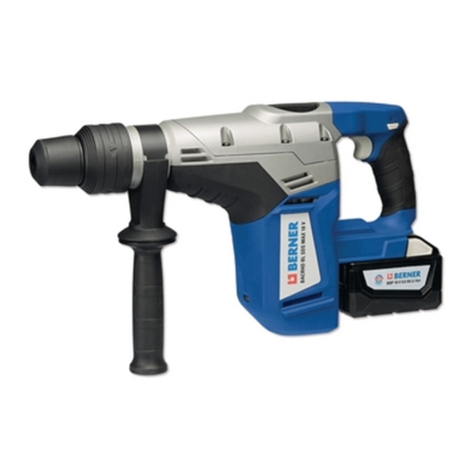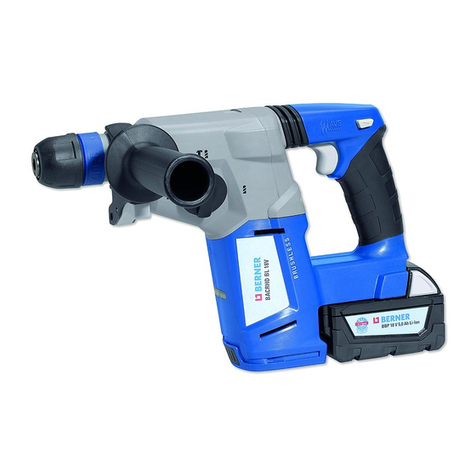Deutsch | 3
1 619 929 L30 • 31.7.12
Deutsch
Allgemeine Sicherheitshin-
weise für Elektrowerkzeuge
Lesen Sie alle Sicherheitshin-
weise und Anweisungen. Ver-
säumnisse bei der Einhaltung der Sicherheitshinwei-
se und Anweisungen können elektrischen Schlag,
Brand und/oder schwere Verletzungen verursachen.
Bewahren Sie alle Sicherheitshinweise und An-
weisungen für die Zukunft auf.
Der in den Sicherheitshinweisen verwendete Begriff
„Elektrowerkzeug“ bezieht sich auf netzbetriebene
Elektrowerkzeuge (mit Netzkabel) und auf akkubetrie-
bene Elektrowerkzeuge (ohne Netzkabel).
Arbeitsplatzsicherheit
fHalten Sie Ihren Arbeitsbereich sauber und
gut beleuchtet. Unordnung oder unbeleuchtete
Arbeitsbereiche können zu Unfällen führen.
fArbeiten Sie mit dem Elektrowerkzeug nicht
in explosionsgefährdeter Umgebung, in der
sich brennbare Flüssigkeiten, Gase oder
Stäube befinden. Elektrowerkzeuge erzeugen
Funken, die den Staub oder die Dämpfe entzünden
können.
fHalten Sie Kinder und andere Personen wäh-
rend der Benutzung des Elektrowerkzeugs
fern. Bei Ablenkung können Sie die Kontrolle über
das Gerät verlieren.
Elektrische Sicherheit
fDer Anschlussstecker des Elektrowerkzeu-
ges muss in die Steckdose passen. Der Ste-
cker darf in keiner Weise verändert werden.
Verwenden Sie keine Adapterstecker ge-
meinsam mit schutzgeerdeten Elektrowerk-
zeugen. Unveränderte Stecker und passende
Steckdosen verringern das Risiko eines elektri-
schen Schlages.
fVermeiden Sie Körperkontakt mit geerdeten
Oberflächen wie von Rohren, Heizungen,
Herden und Kühlschränken. Es besteht ein er-
höhtes Risiko durch elektrischen Schlag, wenn Ihr
Körper geerdet ist.
fHalten Sie Elektrowerkzeuge von Regen
oder Nässe fern. Das Eindringen von Wasser in
ein Elektrowerkzeug erhöht das Risiko eines elektri-
schen Schlages.
fZweckentfremden Sie das Kabel nicht, um
das Elektrowerkzeug zu tragen, aufzuhängen
oder um den Stecker aus der Steckdose zu
ziehen. Halten Sie das Kabel fern von Hitze,
Öl, scharfen Kanten oder sich bewegenden
Geräteteilen. Beschädigte oder verwickelte Ka-
bel erhöhen das Risiko eines elektrischen Schla-
ges.
fWenn Sie mit einem Elektrowerkzeug im
Freien arbeiten, verwenden Sie nur Verlänge-
rungskabel, die auch für den Außenbereich
geeignet sind. Die Anwendung eines für den Au-
ßenbereich geeigneten Verlängerungskabels ver-
ringert das Risiko eines elektrischen Schlages.
fWenn der Betrieb des Elektrowerkzeuges in
feuchter Umgebung nicht vermeidbar ist, ver-
wenden Sie einen Fehlerstromschutzschal-
ter. Der Einsatz eines Fehlerstromschutzschalters
vermindert das Risiko eines elektrischen Schlages.
Sicherheit von Personen
fSeien Sie aufmerksam, achten Sie darauf,
was Sie tun, und gehen Sie mit Vernunft an
die Arbeit mit einem Elektrowerkzeug. Be-
nutzen Sie kein Elektrowerkzeug, wenn Sie
müde sind oder unter dem Einfluss von Dro-
gen, Alkohol oder Medikamenten stehen. Ein
Moment der Unachtsamkeit beim Gebrauch des
Elektrowerkzeuges kann zu ernsthaften Verletzun-
gen führen.
fTragen Sie persönliche Schutzausrüstung
und immer eine Schutzbrille. Das Tragen per-
sönlicher Schutzausrüstung, wie Staubmaske,
rutschfeste Sicherheitsschuhe, Schutzhelm oder
Gehörschutz, je nach Art und Einsatz des Elektro-
werkzeuges, verringert das Risiko von Verletzun-
gen.
fVermeiden Sie eine unbeabsichtigte Inbe-
triebnahme. Vergewissern Sie sich, dass das
Elektrowerkzeug ausgeschaltet ist, bevor Sie
es an die Stromversorgung und/oder den Ak-
ku anschließen, es aufnehmen oder tragen.
Wenn Sie beim Tragen des Elektrowerkzeuges den
Finger am Schalter haben oder das Gerät einge-
schaltet an die Stromversorgung anschließen, kann
dies zu Unfällen führen.
fEntfernen Sie Einstellwerkzeuge oder
Schraubenschlüssel, bevor Sie das Elektro-
werkzeug einschalten. Ein Werkzeug oder
WARNUNG
































